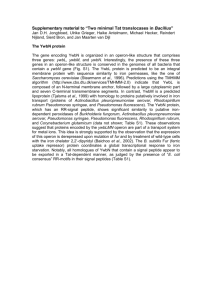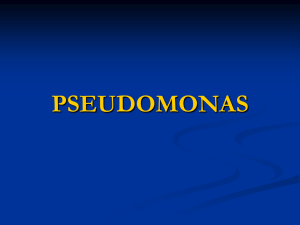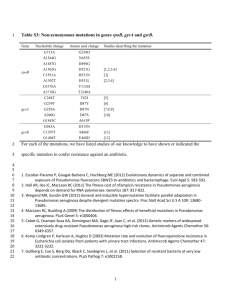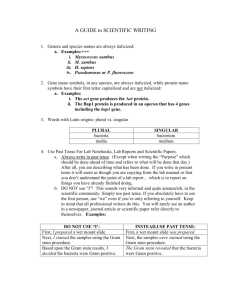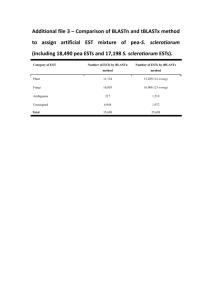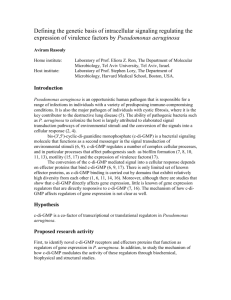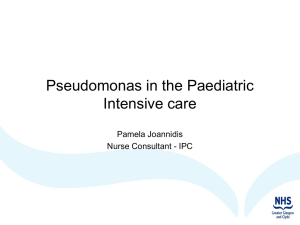Document 13138683
advertisement
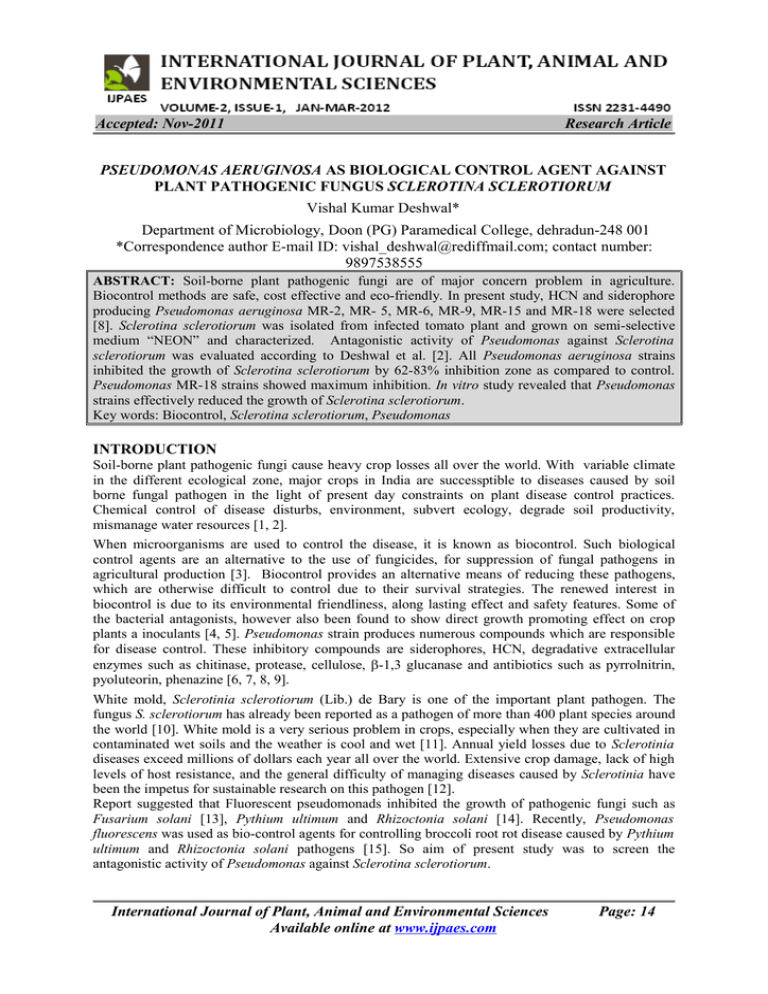
Accepted: Nov-2011 Research Article PSEUDOMONAS AERUGINOSA AS BIOLOGICAL CONTROL AGENT AGAINST PLANT PATHOGENIC FUNGUS SCLEROTINA SCLEROTIORUM Vishal Kumar Deshwal* Department of Microbiology, Doon (PG) Paramedical College, dehradun-248 001 *Correspondence author E-mail ID: vishal_deshwal@rediffmail.com; contact number: 9897538555 ABSTRACT: Soil-borne plant pathogenic fungi are of major concern problem in agriculture. Biocontrol methods are safe, cost effective and eco-friendly. In present study, HCN and siderophore producing Pseudomonas aeruginosa MR-2, MR- 5, MR-6, MR-9, MR-15 and MR-18 were selected [8]. Sclerotina sclerotiorum was isolated from infected tomato plant and grown on semi-selective medium “NEON” and characterized. Antagonistic activity of Pseudomonas against Sclerotina sclerotiorum was evaluated according to Deshwal et al. [2]. All Pseudomonas aeruginosa strains inhibited the growth of Sclerotina sclerotiorum by 62-83% inhibition zone as compared to control. Pseudomonas MR-18 strains showed maximum inhibition. In vitro study revealed that Pseudomonas strains effectively reduced the growth of Sclerotina sclerotiorum. Key words: Biocontrol, Sclerotina sclerotiorum, Pseudomonas INTRODUCTION Soil-borne plant pathogenic fungi cause heavy crop losses all over the world. With variable climate in the different ecological zone, major crops in India are successptible to diseases caused by soil borne fungal pathogen in the light of present day constraints on plant disease control practices. Chemical control of disease disturbs, environment, subvert ecology, degrade soil productivity, mismanage water resources [1, 2]. When microorganisms are used to control the disease, it is known as biocontrol. Such biological control agents are an alternative to the use of fungicides, for suppression of fungal pathogens in agricultural production [3]. Biocontrol provides an alternative means of reducing these pathogens, which are otherwise difficult to control due to their survival strategies. The renewed interest in biocontrol is due to its environmental friendliness, along lasting effect and safety features. Some of the bacterial antagonists, however also been found to show direct growth promoting effect on crop plants a inoculants [4, 5]. Pseudomonas strain produces numerous compounds which are responsible for disease control. These inhibitory compounds are siderophores, HCN, degradative extracellular enzymes such as chitinase, protease, cellulose, β-1,3 glucanase and antibiotics such as pyrrolnitrin, pyoluteorin, phenazine [6, 7, 8, 9]. White mold, Sclerotinia sclerotiorum (Lib.) de Bary is one of the important plant pathogen. The fungus S. sclerotiorum has already been reported as a pathogen of more than 400 plant species around the world [10]. White mold is a very serious problem in crops, especially when they are cultivated in contaminated wet soils and the weather is cool and wet [11]. Annual yield losses due to Sclerotinia diseases exceed millions of dollars each year all over the world. Extensive crop damage, lack of high levels of host resistance, and the general difficulty of managing diseases caused by Sclerotinia have been the impetus for sustainable research on this pathogen [12]. Report suggested that Fluorescent pseudomonads inhibited the growth of pathogenic fungi such as Fusarium solani [13], Pythium ultimum and Rhizoctonia solani [14]. Recently, Pseudomonas fluorescens was used as bio-control agents for controlling broccoli root rot disease caused by Pythium ultimum and Rhizoctonia solani pathogens [15]. So aim of present study was to screen the antagonistic activity of Pseudomonas against Sclerotina sclerotiorum. International Journal of Plant, Animal and Environmental Sciences Available online at www.ijpaes.com Page: 14 Vishal Kumar Deshwal IJPAES ISSN 2231- 4490 MATERIAL AND METHODS Selection of Pseudomonas strains: Pseudomonas aeruginosa MR-2, MR- 5, MR-6, MR-9, MR-15 and MR-18 were selected for present study. All the strains produced HCN and Siderophore [8]. Isolation and characterization of Sclerotina sclerotiorum: Fungus was isolated from infected tomato plant, on semi-selective medium “NEON”. Sterilized PDA medium was taken. Melted the PDA medium and added membrane filter streptomycin sulphate-150 ppm, penicillin-G-150 ppm and bromophenol blue-150 ppm to the medium with temperature 50 ºC. The pH of the medium was around 4.7 [16]. Fungus was purified and microscopic characterization was done according to Bolton et al. [17]. Antagonistic activity of Pseudomonas against Sclerotina sclerotiorum : Antagonistic activity of Pseudomonas strains was tested against Sclerotina sclerotiorum by using dual culture technique [2]. Five-day-old mycelial discs (5 mm diameter) of Sclerotina sclerotiorum were placed at four corners on the modified King’s B medium by including 2% sucrose. Exponentially grown Pseudomonas strain was spotted in the centre of agar plates and incubated at 28 ± 1°C for five days. Inhibition in radial growth of test fungus was measured. One fungal disc was transferred at centre of control plates and radial growth was measured. RESULTS Selected Pseudomonas aeruginosa strains MR-2, MR- 5, MR-6, MR-9, MR-15 and MR-18 were positive for siderophore and HCN [8]. Pure culture of white mold, Sclerotina sclerotiorum was isolated from tomato plant on NEON medium. Microscopic evidence showed that isolated fungus was hyaline, septate, branched and multinucleate, Ascospores had been observed. Dual culture method showed that all Pseudomonas aeruginosa strains inhibited the growth of Sclerotina sclerotiorum by 62-83% inhibition zone as compared to control. Maximum inhibition was observed by Pseudomonas MR-18 (Table-1). Table 1: Evaluation of the biocontrol activity of Pseudomonas aeruginosa against Sclerotina sclerotiorum S. No. Pseudomonas aeruginosa Percentage of Inhibition 1 Pseudomonas MR-2 78 2 Pseudomonas MR- 5 75 3 Pseudomonas MR-6 62 4 Pseudomonas MR-9 71 5 Pseudomonas MR-15 79 6 Pseudomonas MR-18 83 Values are mean of 5 replicates. DISCUSSION Increased concern over the impact of chemical fungicide on the environment has resulted in the increased interest in biocontrol strategies for the management of S. sclerotiorum. Microscopic evidence showed that isolated fungus was Sclerotina sclerotiorum and similar observation had been observed by Bolton et al. [17]. Results showed that selected Pseudomonas strains were effectively controling the growth of Sclerotina sclerotiorum. Previous report suggested that Pseudomonas strains effectively reduced the growth of fungal pathogen. P. fluorescens 2-79 has been shown to produce PCA and AAP [18]. Pseudomonas sp. DF41 reported to be very effective inhibitors of S. sclerotiorum mycelial growth and suppresses germination of sclerotia and ascospores [19]. Presence of phenazine biosynthetic genes and PCA production by PA-23 account for the inhibition of mycelial growth of S. sclerotiorum, in vitro [20, 21,22]. Fernando et al., [23] mentioned that results suggest that P. cholororaphis PA-23 can be used to control Sclerotinia stem rot of canola under field conditions. International Journal of Plant, Animal and Environmental Sciences Available online at www.ijpaes.com Page: 15 Vishal Kumar Deshwal IJPAES ISSN 2231- 4490 Beneficial rhizobacteria are known to colonize rapidly and aggressively the root system, suppress pathogenic microorganism, and enhance plant growth and development [24]. Under certain condition antibiotics improve the ecological fitness of these rhizobacteria in rhizoshpere, which can further influence long-term biological control efficacy [25]. Our in vitro studies showed that Pseudomonas aeruginosa strains effectively inhibited the growth of S. sclerotiorum. This S. sclerotiorum is well known soli borne pathogenic fungi. As literature suggested that biocontrol agent effectively colonize in plant rhizosphere and showed long term effect in soil ecosystem. However, Pseudomonas strains MR- -2, MR- 5, MR-6, MR-9, MR-15 and MR-18 showed promising biocontrol of S. sclerotiorum. REFERENCES [1] Ayala S and Rao EVSP (2002). Perspectives of soil fertility management with a focus on fertilizer use for crop productivity. Curr Sci, 82: 797-807. [2] Deshwal VK, Dubey RC and Maheshwari DK (2003a). Isolation of plant growth promoting strains of Bradyrhizobium Arachis sp. with biocontrol potential against Macrophomina phaseolina causing charcoal rot of peanut. Curr Sci, 84(3): 443-448. [3] Sigler W, Nakatsu CH, Reicher J and Turco R (2001). Fate of the biological control agent Pseudomonas aureofaciens TX-1 after application to turfgrass. Appl and Environ Microbiol, 67: 3542-3548. [4] Glick BR, Karaturovic DM and Newell PC (1995). A novel procedure for rapid isolation of plant growth promoting pseudomonads. Can J Microbiol, 41: 533-536. [5] Deshwal VK, Pandey P, Kang SC and Maheshwari DK (2003b). Rhizobia as a biological control agent against soil borne plant pathogenic fungi. Ind J Exp Biol, 41: 1160-1164. [6] Dowling DN and O’Gara F (1994). Metabolities of Pseudomonas involved in the biocontrol of plant disease. Treads Biotechnol, 12:133-141. [7] Haas D and Défago G (2005). Biological control of soil-borne pathogens by fluorescent pseudomonads. Nat Rev Microbiol, 3: 307-319. [8] Deshwal VK, Devi MS, Bhajanka N, Mistri J, Bose A and Saini N (2011a). Pseudomonas aeruginosa strains and their role in plant growth promotion in medicinal plant. Global J Appl Agr Res, 1: 49-55. [9] Deshwal VK, Vig K, Amisha, Dwivedi M, Yadav P, Bhattacharya D and Verma M (2011b). Synergistic effects of the inoculation with plant growth-promoting Rhizobium and Pseudomonas on the performance of Mucuna. Annals of Forestry, 19(1): 13-20. [10] Boland GJ and Hall R (1994). Index of plant hosts of Sclerotinia sclerotiorum. Can J Plant Pathol, 16: 93-108. [11] Reis A and Lopes CA (2007). Principais fungos de solo em Hortaliças: Epidemiologia e manejo. In: Zambolim L; Lopes CA; Picanço MC; Costa, H (orgs). Manejo integrado de doenças e pragas: Hortaliças. Viçosa: UFV. pp. 189-224. [12] Júnior CGL, Gomes EV, Júnior ML, Nasser LCB and Petrofeza S (2011). Genetic diversity and mycelial compatibility groups of the plant-pathogenic fungus Sclerotinia sclerotiorum in Brazil. Genetics and Mol Res, 10 (2): 868-877. [13] Lim HS and Kim SD (1995). The role and characterization of β-1,3- Gluconase in biological control of Fusarium solani by Pseudomonas stutzeri YPL-1. J Microbiol, 33: 295-301. [14] Bagnasco P, De La Fuente L, Gualtieri G, Noya F and Arias A (1998). Fluorescent Pseudomonas spp. as biocontrol agents against forage legume root pathogenic fungi. Soil Biol Biochem, 30: 1317-1322. International Journal of Plant, Animal and Environmental Sciences Available online at www.ijpaes.com Page: 16 Vishal Kumar Deshwal IJPAES ISSN 2231- 4490 [15] El-Mohamedy RSR, Abd El-Samad EH, Habib HAM, Fath El-Bab TSH (2011). Effect of using bio-control agents on growth, yield, head quality and root rot control in Broccoli plants. Int J Acad Res, 3(2): 71-80. [16] Peres AP, Nasser LCB and Machado JC (2002). Use of semi-seletive media for detection of Sclerotinia sclerotiorum on bean and soybean seeds. Fitopatologia Brasileira, 27:123-127. [17] Bolton MD, Thomma BPHJ and Nelson BD (2006). Sclerotinia sclerotiorum (Lib.) de Bary: biology and molecular traits of a cosmopolitan pathogen. Mol Plant Patho, 7(1): 1–16. [18] Slininger PJ, Burkhead KD, Schisler DF and Bothast RS (2000). Isolation, identification, and accumulation of 2-acetamidophenol in liquid cultures of the wheat take all biocontrol agent Pseudomonas fluorescens 2-79. Appl Microbiol Biotechnol, 54: 376-381. [19] Savchuk SC (2002). Evaluation of biological control control of Sclerotinia scleroiorum on Canola (Brassica napus) in the lab, in the greenhouse, and in the field. M.Sc. thesis, University of Manitoba,pp. 49-83. [20] Zhang Y, Fernando WGD, de Kievit T, Berry C, Daayf F and Paulitz TC (2006). Detection of antibiotic-related genes from bacterial biocontrol agents using polymerase chain reaction. Can J Microbiol, 52: 476-481. [21] Zhang Y and Fernando WGD (2004a). Zwittermicin A detection in Bacillus spp. controlling Sclerotinia sclerotiorum on canola. Phytopathol, 94: S116. [22] Zhang Y and Fernando WGD (2004b). Presence of biosynthetic genes for phenazine-1carboxylic acid and 2, 4- diacetylphloroglucinol and pyrrolnitrin in Pseudomonas chlororaphis strain PA-23. Can J Plant Pathol, 26: 430-431. [23] Fernando WGD, Nakkeeran S, Zhang Y and Savchuk S (2007). Biological control of Sclerotinia sclerotiorum (Lib.) de Bary by Pseudomonas and Bacillus species on canola petals. Crop Protection, 26: 100-107 [24] Weller DM (1988). Biological control of soil borne pathogen in the rhizosphere with bacteria. Annu Rev Phypathol, 26: 379-407. [25] Shanahan P, O’ Sullivan DJ, Simpson P, Glennon JD and O’Gara F (1992). Isolation of 2,4Diacetylphloroglucinol from a fluorescent pseudomonads and investigation of physiological parameters influencing its production. Appl Environ Microbiol, 58:353-358. International Journal of Plant, Animal and Environmental Sciences Available online at www.ijpaes.com Page: 17

